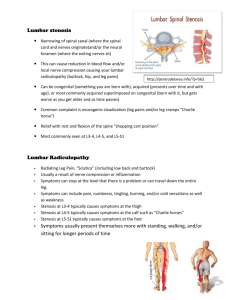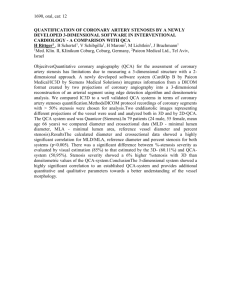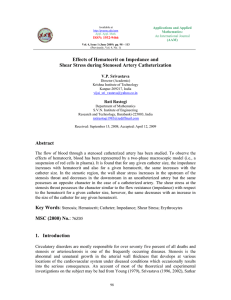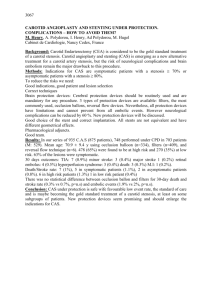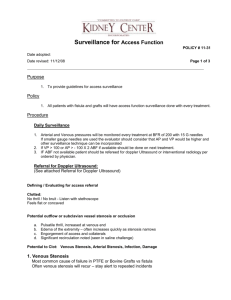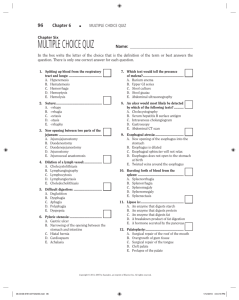Particulate Suspension Blood Flow through a Stenosed Catheterized Artery
advertisement
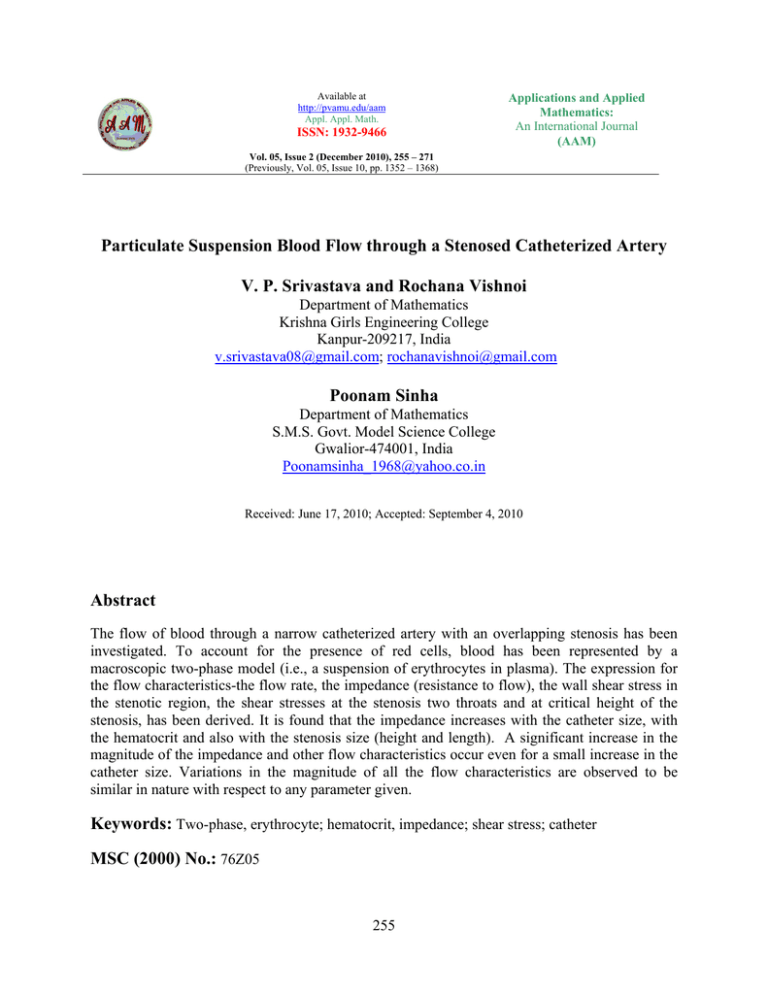
Available at http://pvamu.edu/aam Appl. Appl. Math. ISSN: 1932-9466 Applications and Applied Mathematics: An International Journal (AAM) Vol. 05, Issue 2 (December 2010), 255 – 271 (Previously, Vol. 05, Issue 10, pp. 1352 – 1368) Particulate Suspension Blood Flow through a Stenosed Catheterized Artery V. P. Srivastava and Rochana Vishnoi Department of Mathematics Krishna Girls Engineering College Kanpur-209217, India v.srivastava08@gmail.com; rochanavishnoi@gmail.com Poonam Sinha Department of Mathematics S.M.S. Govt. Model Science College Gwalior-474001, India Poonamsinha_1968@yahoo.co.in Received: June 17, 2010; Accepted: September 4, 2010 Abstract The flow of blood through a narrow catheterized artery with an overlapping stenosis has been investigated. To account for the presence of red cells, blood has been represented by a macroscopic two-phase model (i.e., a suspension of erythrocytes in plasma). The expression for the flow characteristics-the flow rate, the impedance (resistance to flow), the wall shear stress in the stenotic region, the shear stresses at the stenosis two throats and at critical height of the stenosis, has been derived. It is found that the impedance increases with the catheter size, with the hematocrit and also with the stenosis size (height and length). A significant increase in the magnitude of the impedance and other flow characteristics occur even for a small increase in the catheter size. Variations in the magnitude of all the flow characteristics are observed to be similar in nature with respect to any parameter given. Keywords: Two-phase, erythrocyte; hematocrit, impedance; shear stress; catheter MSC (2000) No.: 76Z05 255 256 V.P. Srivastava et al. 1. Introduction The cardiovascular disease stenosis or arteriosclerosis, responsible for deaths in many of the cases, is a medical term which means narrowing of anybody passage, tube or orifice. It is an unnatural and abnormal growth in the arterial wall thickness that develops under diseased conditions, and occasionally results into serious consequences (Srivastava, 1996). Although the root causes of the disease are not well known, it is established that once an obstruction has developed, it results into significant changes in blood flow, pressure distribution, wall shear stress and the impedance (flow resistance). The possibility that the hemodynamic factors play an important role in the genesis and proliferation of the disease, since the first investigation of Mann et al. (1938), this area of knowledge has attracted the attention of early investigators (Young, 1968; Young and Tsai, 1973; Deshpande et al., 1976; Caro et al., 1978; Ahmed and Giddens, 1983; etc.). An account of the most of the theoretical and experimental investigations, reported so far, may be had found in Young (1979), Srivastava (1996), Sarkar and Jayraman (1998), Misra and Verma (2007), Mekheimer and Kot (2008), Srivastava and coworkers, (2009, 2010a,b,c), etc. Being a suspension of corpuscles, at low shear rates blood behaves like a non-Newtonian fluid (Srivastava and Srivastava, 1983). It is well known from the investigations of Haynes (1960) and Cokelet et al. (1972) that blood can no longer be treated as single-phase homogeneous viscous fluid while flowing through narrow arteries (of diameter 1000 μ m). Srivastava and Srivastava (1983) observed that the individuality of red cells (of diameter 8 μ m) is important even in such large vessels of diameter up to 100 cells diameter. Thus, for an accurate description of flow requires the consideration of erythrocytes (red cells) as discrete particles in small blood vessels (Skalak, 1972; Srivastava, 2007). In modern medicine, the use of catheters is of immense importance and has become a standard tool for diagnosis and treatment. When a catheter is inserted into the stenosed artery, the further increased impedance (resistance to flow) and shear stress will alter the flow field. Recently, Srivastava and Srivastava (2009) have presented a brief review of the literature on artery catheterization with and without stenosis. A survey of the literature on stenotic development indicates that most of the studies in the literature are mainly concerned with single symmetric or non-symmetric stenoses. In a realistic situation, however, the constrictions may develop in series (multiple stenoses), may be of irregular shapes, overlapping, composite in nature, etc. Assuming the pressure variation only along the axis of the tube, Chakravarty and Mandal (1994) studied analytically the effects of an overlapping stenosis on arterial flow problem of blood. Layek et al. (2009) investigated the effects of an overlapping stenosis on flow characteristics considering the pressure variation in both the radial and axial directions of the arterial segment under consideration and most recently Srivastava et al. (2010b) addressed the problem of blood flow through an overlapping stenosis assuming that the flowing blood is represented by a two-layered macroscopic two-phase model (Srivastava, 2007). An effort is made in the present investigation to explore the effects of the inserted catheter in an artery with overlapping stenosis assuming that the flowing blood is represented by a macroscopic two-phase model (i.e., a suspension of erythrocytes in plasma). The wall in the vicinity of the stenosis is usually relatively solid when it develops in the living vasculature. AAM: Intern. J., Vol. 05, Issue 2 (December 2010) [Previously, Vol. 05, Issue 10, pp. 1352 – 1368] 257 2. Formulation of the Problem Consider the axisymmetric flow of blood through a catheterized artery with an overlapping stenosis. The artery is assumed to be a rigid circular tube of radius R0 and the catheter as a coaxial rigid tube of radius Rc. The artery length is considered large enough as compared to its radius so that the entrance, end and special wall effects can be neglected. The geometry of the stenosis, assumed to be manifested in the arterial segment is described (Chakravarty and Mandal, 1994; Layek et al., 2009; Srivastava, et al., 2010b) in Fig. 1 as 3 3 2 2 3 4 1 2 R L4 11( z d ) L0 47( z d ) L0 72( z d ) L0 36( z d ) 0 0 R( z ) d z d L0 , R0 1, otherwise (1) where R (z) is the radius of the tube with stenosis, L0 is the length of the stenosis and d indicates its location, is the maximum height of the stenosis into the lumen, appears at Figure 1. Flow geometry of an overlapping stenosis in a catheterized artery. the two different locations: z d L0 / 6 and z d 5 L0 / 6 . The height of the stenosis at z d L0 / 2 , called critical height is 3 / 4 . Blood is assumed to be represented by a macroscopic two-phase model, that is, a suspension of erythrocytes (red cells) in plasma. The equations describing the steady flow of a macroscopic two-phase model of blood may be expressed (Srivastava and Srivastava, 1983) as 258 V.P. Srivastava et al. u f u f p vf (1-C) f u f (1 C ) s (C ) 2u f = - (1- C) z r z + CS ( u p u f ), (2) v f v f p vf (1-C) f u f (1 C ) s (C ) = - (1 - C) z r r x ( 2 1 ) v f + CS ( v p v f ), r2 (3) 1 r (1 C ) v f (1 C ) u f 0 , r r z (4) u u p C p up p vp p = - C C S ( u f u p ), z z r (5) v v p C p u p p vp p = - C CS ( v f v p ), r r z (6) 1 r C vp C up 0, r r z (7) with 2 (1 / r ) / r (r / r ) 2 / z 2 as Laplacian operator, r and z are the cylindrical polar coordinate system with z measured along the tube axis and r perpendicular to the axis of the tube. (uf, up) and (vf, vp) are the axial and radial components of the (fluid, particle velocity), f and p are the actual density of the material constituting the fluid (plasma) and the particle (erythrocyte) phases, respectively, (1-C) f is the fluid phase and C p is particle phase densities, C denotes the volume fraction density of the particles, p is the pressure, s (C) ~ s is the mixture viscosity (apparent or effective viscosity) , S is the drag coefficient of interaction for the force exerted by one phase on the other, and the subscripts f and p denote the quantities associated with the plasma (fluid) and erythrocyte (particle) phases, respectively. The pressure gradients have been assumed to be same for the two phases (fluid and particle) which is true in most of the practical situations (Drew, 1979; Srivastava and Srivastava, 1983). Other conditions are same as stated in Srivastava and Srivastava (2009). The expressions for the viscosity of suspension, s, and the drag coefficient of interaction, S for the present problem are chosen (Srivastava and Srivastava, 2009) as S = 4.5 (o / a ) 2 o 4 3[8 C 3 C 2 ] 1 / 2 3 C (2 3 C ) 2 (8) AAM: Intern. J., Vol. 05, Issue 2 (December 2010) [Previously, Vol. 05, Issue 10, pp. 1352 – 1368] s s (C) = o 1 mC 259 , m = 0.07 exp [2.49C + ( 1107 ) exp (-1.69C)], T (9) where o is the plasma viscosity, a o is the radius of a red cell and T is measured in absolute temperature (oK ). To obtain the solution of equations (2)–(7) seems to be a formidable task due to the non-linearity of convective acceleration terms. Depending thus on the size of the stenosis (Young, 1968; Srivastava and Rastogi, 2010a), however, certain terms in these equations are of less importance than other. Considering, therefore, the case of a mild stenosis, under the conditions (Young, 1968; Srivastava and Rastogi, 2009): / R0 1, Re (2 / L0 ) 1 and 2 R0 / L0 ~ O(1) , equations (2)- (7) are simplified to (1-C) C dp (1 C ) s (r ) u f CS (u p u f ), dz r r r (10) dp CS (u f u p ) . dz (11) where Re is the tube Reynolds number. The boundary conditions are uf = 0 on r = R(z), uf = 0 on r = Rc . 3. (12) Analysis The expression for the velocities, uf and up obtained as the solution of equations (10) and (11) under the boundary conditions (12), are given as 2 2 R02 (R/R0 ) 2 (Rc /R0 ) 2 dp R r r log uf , 4( 1 C) μ s dz R0 R0 log (Rc /R) R (13) 260 V.P. Srivastava et al. 2 2 2 2 R02 dp R r (R / R0 ) (Rc / R0 ) r 4( 1 C)μs log up . (14) 4( 1 C)μs dz R0 R0 log (Rc / R) R SR02 The volumetric flow flux, Q is now calculated as R Q 2π r ( 1 C)u f Cu p dr Rc Ro4 ( R / Ro ) 2 2 (dp / dz ) =8 (1 C ) s R Ro 2 ( R / Ro ) 2 2 2 , log ( R / Ro ) / (15) with =8C (1-C) s / S Ro2 , a non-dimensional suspension parameter and =Rc/Ro. The pressure drop, p (= p at z = 0, - p at z = L) across the stenosis is derived from equation (15) as L L 8 (1 C ) s Q dp dz ( z ) dz , p = (16) 4 dz R o o o with R 2 (z) = 1/ 2 Ro R 2 ( R / Ro ) 2 2 2 . log ( R / Ro ) / Ro The expressions for the impedance (flow resistance), and wall shear stress in the stenotic region, τ w , the shear stress at the stenosis two throats, τ s and the shear stress at the stenosis critical height, τ c are given by p Q = τw = - 8 (1 C ) s , Ro4 4 (1 C ) s Q R dp = Ro3 2 dz (17) R ( z ) , Ro (18) τs 4( 1 C)μ s Q ( 1 5δ/ 4 R0 )φ(z)R/R0 15δ/ 4 R0 , πR03 (19) τc 4( 1 C)μs Q ( 1 3δ / 4 R0 ) φ(z)R / R 13δ / 4 R , 0 0 πR03 (20) AAM: Intern. J., Vol. 05, Issue 2 (December 2010) [Previously, Vol. 05, Issue 10, pp. 1352 – 1368] 261 where L ( z) dz = [ ( z )] = d Lo d o R / Ro 1 dz + L ( z) dz ( z ) R / Ro 1 d Lo d o dz . (21) The closed form analytical evaluation of the second integral in the expression for (equation (21)) seems to be a formidable task and thus shall be evaluated numerically whereas the evaluation of the first and the third integrals is straightforward. Following thus Srivastava et al. (2010b), one obtains the final expression for flow resistance, , wall shear stress, τ w , shearing stress at the stenosis throats, s and the shear stress at the stenosis critical height, τ c in their nondimensional form as d L 1 L0 /L 1 0 λ ( 1 C)μ L d Ω (R/R 0 ) 2 ε 2 τw (R/R 0 τs ) ε 2 ( 1-5δ/ 4R 2 (22) ( 1 C) μ (R/R0 ) , (R/R0 ) ε 2 (R/R0 )2 ε 2 / log(R/R0 )/ε β ) ε 2 0 dz , 2 2 (R/R 0 ) ε 2 2 (R/R0 ) ε β log(R/R 0 )/ε 2 2 (23) ( 1 C) μ 1-5δ / 4 R0 , ( 1 5δ/ 4 R0 ) ε 2 ( 1-5δ/ 4 R0 ) 2 ε 2 / log( 1 5δ/ 4 R0 )/ε β 2 (24) τc ( 1-3δ/ 4 R ) ε 2 0 2 ( 1 C) μ 1-3δ / 4 R0 , ( 1 3δ/ 4 R0 ) ε 2 ( 1-3δ/ 4 R0 ) 2 ε 2 / log( 1 3δ/ 4 R0 )/ε β 2 (25) where / o , (τ w , τ s , τ c ) ( τ w , τ s , τ c )/τ 0 , s / o , 8 o L / Ro4 , 0 o 4 o Q / Ro3 , Ω= (1- 2 ) 1 2 (1 2 ) / log , o and o are resistive impedance and wall shear stress, respectively for an uncatheterized normal artery (no stenosis) in the absence of the particle phase (C = 0). 262 V.P. Srivastava et al. In the absence of the catheter (i.e., under the limit 0 ), one derives the expressions for , τ w , s and τ c , respectively for the flow of a macroscopic two-phase model of blood through an overlapping stenosis as 1 1 L (1 o ) L L 1 (1 C ) d Lo d dz [( R / Ro ) ( R / Ro ) 2 ] 4 , (26) τw ( 1 C) μ , (R/R0 )3 β(R/R0 ) (27) τs ( 1 C) μ , ( 1-5δ / 4 R0 )3 β( 1-5δ / 4 R0 ) (28) τc ( 1 C) μ , ( 1-3δ / 4 R0 )3 β( 1-3δ / 4 R0 ) (29) In addition, in the absence of the erythrocyte phase (i.e., C = 0), the results obtained in equations (24)–(26) assume the form L 1 = 1 o L L d Lo d dz , ( R / Ro ) 4 (30) τw 1 , (R/R0 )3 (31) τs 1 , ( 1-5δ / 4 R0 )3 (32) τc 1 , ( 1-3δ / 4 R0 )3 (33) which correspond to the results obtained in Srivastava (1995) for Newtonian fluid case. 4. Numerical Results and Discussion To observe the influence of various parameters involved in the study, particularly, the catheter size and the hematocrit, computer codes are now developed to evaluate the analytical results obtained in equations (22)-(25) at the temperature of 370C. Parameter values are selected from Young (1968), Back (1994), Srivastava (1996) and Srivastava et al. (2010b) as 2ao (diameter of AAM: Intern. J., Vol. 05, Issue 2 (December 2010) [Previously, Vol. 05, Issue 10, pp. 1352 – 1368] 263 an erythrocyte) = 8 m ; C (hematocrit) =0, 0.2, 0.4, 0.6; Ro (radius of normal artery) = 0.01 cm; / Ro (non-dimensional stenosis height) = 0, 0.05, 0.10, 0.15, 0.20; Lo (stenosis length, cm) =1; L (artery length, cm ) =1, 2, 5; (non-dimensional catheter radius) = 0, 0.1, 0.2, 0.3, 0.4, 0.5, 0.6. The present study corresponds to the macroscopic two-phase model of blood flow through an uncatheterized artery, to the flow through a normal catheterized artery and to the flow of a single-phase Newtonian viscous fluid for parameter values: 0, / Ro = 0 and C=0, respectively. 15 .5 C=.4 Numbers 12 9 .4 6 .3 .2 3 .1 0 0 0.00 0.05 /R 0 0.10 0.15 0.20 Fig.2 Impedance, versus stenosis height, /R 0 for different . 12 10 .6 Numbers C .4 8 0 6 =.3 4 .4 0 .6 2 =0 0 0.00 0.05 /R 0 0.10 0.15 Fig.3 Impedance, versus stenosis height, /R 0 for different C. 0.20 264 V.P. Srivastava et al. The resistive impedance (resistance to flow), λ increases with stenosis height, δ/R 0 as well as with cell concentration, C in both the catheterized and uncatheterized arteries. It is observed that the presence of the catheter causes further significant increase in the magnitude of the impedance, in addition to that has occurred due to the presence of the stenosis (Fig. 2), One notices that any small increase in the catheter size, ε causes reasonable effect on the flow resistance, (Figure. 2). For any given stenosis height, δ/R 0 , the impedance, increases with hematocrit, C for any given catheter size, ε (Figure. 3). The magnitude of increases with catheter size, ε for any given set of other parameters. 40 _____ C=0 .......... C=.4 Numbers /R0 35 30 25 .2 20 .05 15 .15 10 .1 0 5 0 0.4 0.5 0.6 0.3 Fig.4 Impedance, versus catheter size, for different C and /R0. 0.0 0.1 0.2 However, for small values of ε ( 2.5), the impedance, λ increases steeply but increases rapidly for higher catheter size, ε and assumes a very high asymptotic magnitude for a given catheter size, ε depending on the stenosis height, δ/R 0 (Figure. 4). The flow resistance, seems to be increasing steeply with hematocrit, C for any given catheter size, ε and stenosis height, δ/R 0 (Figure.5). The impedance, decreases with the increasing values of L which in turn implies that the flow resistance increases with increasing stenosis length, L0 (Fig. 6). At any point in the stenotic region the wall shear stress increases with increasing catheter size, ε for a given hematocrit, C and stenosis height, δ/R 0 . The flow characteristic, τ w increases rapidly from its approached value at z/L0 0 to its peak value at stenosis first throat at z/L 0 1/6 in both the catheterized and uncatheterized arteries. It steeply decreases from its peak value at AAM: Intern. J., Vol. 05, Issue 2 (December 2010) [Previously, Vol. 05, Issue 10, pp. 1352 – 1368] 265 stenosis first throat to its magnitude at critical stenosis height (i.e., at z/L0 1/ 2 ) and further increases steeply from its value at critical stenosis height to its peak value at stenosis second throat (i.e. at z/L0 5 / 6 ). τ w then decreases rapidly from its peak value at stenosis second throat to its approach value (i.e., at z/L0 0 ) at the end point of the stenotic region (Fig.7). One notices that for a given catheter size, ε, the blood flow characteristics, τ w increases with both hematocrit, C and stenosis height, δ/R 0 at any axial distance in the stenotic region (Figure.8). 10 Numbers (, /R0) (.3,.15) 8 (.3,.10) 6 4 (.3,0) (0,.15) 2 (0,.10) (0,0) 0.0 0.1 0.2 C 0.3 0.4 0.5 0.6 Fig.5 Impedance, versus hematocrit, C for different and /R0. 6 C=.4 _____ L=1 --------- L=2 ...........L=5 Numbers .3 5 4 .1 3 0 .3 .3 .1 2 0 1 .1 0 0.00 0.05 0 /R0 0.10 0.15 Fig.6 Impedance, versus stenosis height, /R0 for different and L. 0.20 266 V.P. Srivastava et al. 35 .5 C=.4 /R0=.15 Numbers 30 25 20 w .4 15 10 .3 5 .1 0 .2 0 0.0 0.2 0.4 0.6 0.8 z/L0 Fig.7 Wall shear stress in the stenotic region, w for different . 1.0 One observes that, τ w assumes same magnitude at stenosis two throats (Fig.7and Fig. 8). 9 =.3 Numbers (C, /R0) 8 7 w (.4,.15) 6 (.4,.10) (0,.15) 5 (0,.10) 4 3 0.0 0.2 0.4 0.6 0.8 z/L0 Fig.8 Wall shear stress in the stenotic region, w for different C and /R0. 1.0 AAM: Intern. J., Vol. 05, Issue 2 (December 2010) [Previously, Vol. 05, Issue 10, pp. 1352 – 1368] 267 The shear stress at stenosis throats, τ s increases with stenosis height, δ/R 0 , with hematocrit, C as well as with catheter size, ε (Fig. 9 and Fig. 10). Depending on the height of the stenosis, δ/R 0 , the blood flow characteristics, τ s attains a very high asymptotic magnitude with increasing catheter size, ε (Fig. 10). The flow characteristics, τ c (shear stress at stenosis critical height located at z/L 0 1/2 ) too increases with stenosis height, δ/R 0 , the hematocrit, C and catheter size, ε (Fig. 11 and Fig. 12). For any given set of parameters, the magnitude of the blood flow characteristic, τ c assumes significantly lower value than the corresponding value of the shear stress at stenosis two throats (Fig. 9 and Fig. 11). An inspection of Figs. 2-6 and Figs. 9-12, reveals that the variations in the flow characteristics, τ s and τ c are similar to that of the flow resistance, with respect to any parameter. The significance of the present work is well understood from the above discussion. The condition: / Ro <<1 limits the usefulness of the present study to very early stages of the vessel constriction, which allows the use of fully developed flow equations and closed form solutions. The use of the parameter / Ro is restricted to the value of up to 0.15 (i.e., 28% stenosis by area reduction) as beyond this value a separation in the flow may occur (Srivastava, 1996). The justifications for the use of the two-phase equations in the present work are given in Srivastava and Srivastava (1983) and Drew (1979), rigid wall assumption in Haynes (1960) and Bugliarello and Sevilla (1970) and the validity of steady flow model in (Young, 1968; Srivastava, 1995). These are therefore not repeated here for the sake of further discussion. 20 .5 C=.4 Numbers 15 s 10 .4 .3 5 .2 .1 0 0 0.00 0.05 /R0 0.10 0.15 Fig. 9 Shear stress at stenosis throat, s versus stenosis height, /R0 for different . 0.20 268 V.P. Srivastava et al. 40 35 ______ C=0 ........... C=.4 Numbers /R0 30 s .2 .10 25 .15 20 15 .05 10 0 5 0 0.1 0.2 0.4 0.5 0.6 0.3 Fig.10 Shear stress at stenosis throat, s versus catheter size, for different C and /R0. 0.0 16 C=.4 Numbers .5 12 c 8 .4 .3 4 .2 .1 0 0 0.00 0.05 /R0 0.10 0.15 Fig.11 Shear stress at stenosis critical height, c versus stenosis height, /R0 for different . 0.20 AAM: Intern. J., Vol. 05, Issue 2 (December 2010) [Previously, Vol. 05, Issue 10, pp. 1352 – 1368] 269 20 .15 ______ C=0 ........... C=.4 Numbers /R0 16 .2 .05 .1 12 0 c 8 4 0 0.0 0.1 0.2 0.3 0.4 0.5 0.6 Fig.12 Shear stress at stenosis critical height, c versus catheter size, for different C and /R0. 5. Conclusions To estimate the effects of hematocrit on the increased impedance and other flow characteristics during artery catheterization in the presence of an overlapping stenosis, a macroscopic two-phase model for blood has been applied to discuss the flow through a catheterized artery with an overlapping stenosis. The impedance increases with hematocrit in both the catheterized and uncatheterized artery. The two-phase fluid seems to be more sensitive to the inserted catheter than a single-phase fluid. Depending on the size of the stenosis, the flow resistance assumes a very high asymptotic magnitude with increasing catheter size. One thus needs to choose the size of a catheter keeping the stenosis height in mind during the medical treatment. However, the study suggests that the catheter size should not exceed more than fifty percent of the artery size in any situation. The wall shear stress in the stenotic region, the shear stress at the stenosis two throats possess characteristics similar to that of the flow resistance with respect to any parameter given. It is important to note that the shear stress at stenosis two throats, assume the same magnitude and attains significantly higher value than its corresponding magnitude at the stenosis critical height. Although, the present study has been conducted under several restrictions including the rigid wall, steady flow and mild stenosis, one is still remarkably able to observe the effects of hematocrit on increased magnitude of the flow characteristics during catheterization in a stenosed artery. The considerations of a pulsatile flow and severe cases of stenosis remain the future scope of the study. Further careful investigations are suggested in order to address the problem more realistically and to overcome some of the restrictions imposed on the present investigation. 270 V.P. Srivastava et al. REFERENCES Ahmed, A. S. and Giddens, D. P. (1983). Velocity measurements in steady flow through axisymmetric stenosis at moderate Reynolds number. Journal of Biomech., Vol. 16, pp. 505516. Back, L.H. (1994). Estimated mean flow resistance increases during coronary artery catheterization. J. Biomech., Vol. 27, pp. 169-175. Bugliarello, G. and Sevilla, J. (1970). Velocity distribution and other characteristics of steady and pulsatile blood flow in fine glass tubes. Biorheol., Vol. 7, pp. 85-107. Caro, C. G. Pedley, T. J., Schroter, R.C. and Seed, W. A. (1978). The Mechanics of the Circulation. Oxford Medical, N. Y, Chakravarty, S. and Mandal, P. K. (1994). Mathematical modelling of blood flow through an overlapping stenosis. Math. Comput. Model,, Vol. 19, pp. 59-73. Cokelet, G.R. (1972). The Rheology of Human Blood: In Biomechanies, Prentice-Hall, Englewood Cliffs, N.J. Deshpande, M. D. Giddens, D. P. and Mabon R. F. (1976). Steady laminar flow through modeled vascular stenosis. Journal of Biomechanics, 9, 165-174. Drew, D.A. (1979). Stability of Stokes Layer of a Dusty Gas, Physics Fluids, Vol. 19, pp. 20812084. Haynes, R.H. (1960). Physical Basis on Dependence of Blood Viscosity on Tube Radius, American Journal of Physiology, Vol. 198, pp.1193-1205. Layek, G. C., Mukhopadhyay, S. and Gorla, R. S. D. (2009). Unsteady viscous flow with variable viscosity in a vascular tube with an overlapping constriction. Int. J. Engng. Sci., Vol. 47, pp. 649-659. Mann, F. C., Herrick, J. F., Essex, H. E. and Blades, E. J. (1938). Effects on blood flow of decreasing the lumen of blood vessels. Surgery, Vol. 4, pp.249-252. Mekheimer, Kh. S. and Kot, A. M. E. (2008). Magnetic field and hall currents influences on blood flow through a stenotic arteries, Applied Mathematics and Mechanics, Vol.29, pp. 112. Mishra, B. K. and Verma, N. (2007). Effects of porous parameter and stenosis on the wall shear stress for the flow of blood in human body. Res. J. medicine and Medical Sciences, Vol.2, pp. 98-101. Sarkar, A. and Jayaraman, G. (1998). Correction to flow rate-pressure drop in coronary angioplasty; steady streaming effect. Journal of Biomech., Vol. 31, pp. 781-791. Skalak, R. (1972). Mechanics of microcirculation: In Biomechanics, Its foundation and Objectives, Prentice Hall, Englewood Cliffs. Srivastava, L. M. and Srivastava, V. P. (1983). On two-phase model of pulsatile blood flow with entrance effects. Biorheol., Vol. 20, pp. 761-777. Srivastava, V. P. (2007). A theoretical model for blood flow in small vessels. Applications and Applied Mathematics, Vol. 2, pp. 51-65. Srivastava, V. P. and Rastogi, R. (2010a). Blood flow through stenosed catherterized artery: effects of hematocrit and stenosis shape. Comput. Math. Applc., Vol. 59, pp. 1377-1385. Srivastava, V. P., Rastogi, Rati and Vishnoi, Rochana (2010b). A two-layered suspension blood flow through an overlapping stenosis. Comput. Math. Applc., Vol. 60, pp. 432-441, 2010b. AAM: Intern. J., Vol. 05, Issue 2 (December 2010) [Previously, Vol. 05, Issue 10, pp. 1352 – 1368] 271 Srivastava, V. P., Rastogi, Rati and Mishra, Shailesh (2010c). Non-Newtonian arterial blood flow through an overlapping stenosis. Applications and Applied Mathematics, Vol. 5, pp. 225-238. Srivastava, V. P. and Rastogi, R. (2009). Effects of hematocrit on impedance and shear stress during stenosed artery catheterization. Applications and Applied Mathematics, Vol. 4, pp. 98-113. Srivastava, V. P. (1995). Arterial blood flow through a nonsymmetrical stenosis with applications. Jpn. J. Appl. Phys., Vol. 34, pp. 6539-6545. Srivastava, V.P. and Srivastava, Rashmi (2009). Particulate Suspension Blood Flow through a Narrow Catheterized Artery, Computer and Mathematics with Applications, Vol. 58, pp. 227-238. Srivastava, V.P. (1996). Two-phase Model of Blood Flow Through Stenosed Tubes in the Presence of a Peripheral Layer. J. Biomech., Vol. 29, pp. 1377-1382. Young, D. F. and Tsai F. Y. (1973). Flow characteristics in model of arterial stenosis – steady flow. Journal of Biomech., Vol. 6, pp. 395-410. Young, D. F. (1968). Effects of a time-dependent stenosis of flow through a tube. Journal of Eng. Ind., Vol. 90, 248-254. Young, D. F. (1979). Fluid mechanics of arterial stenosis. Journal of Biomech. Eng,, Vol. 101, pp. 157-175.

